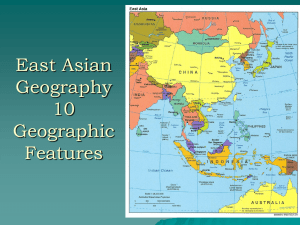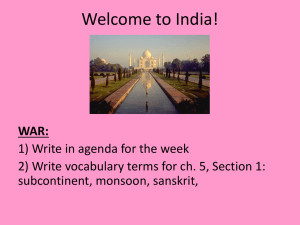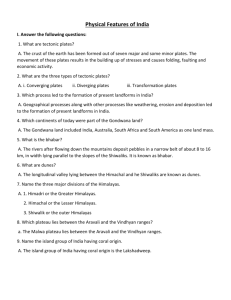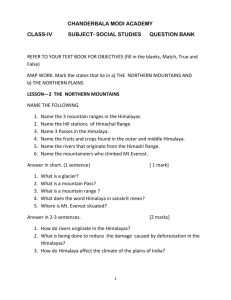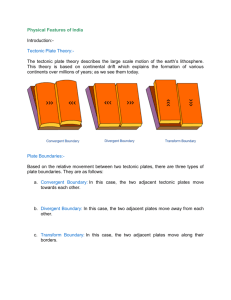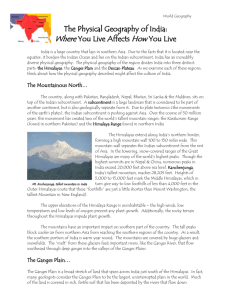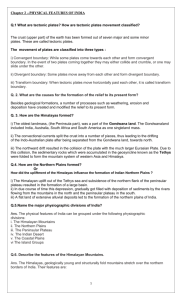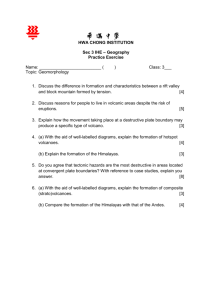physical features of india class ix
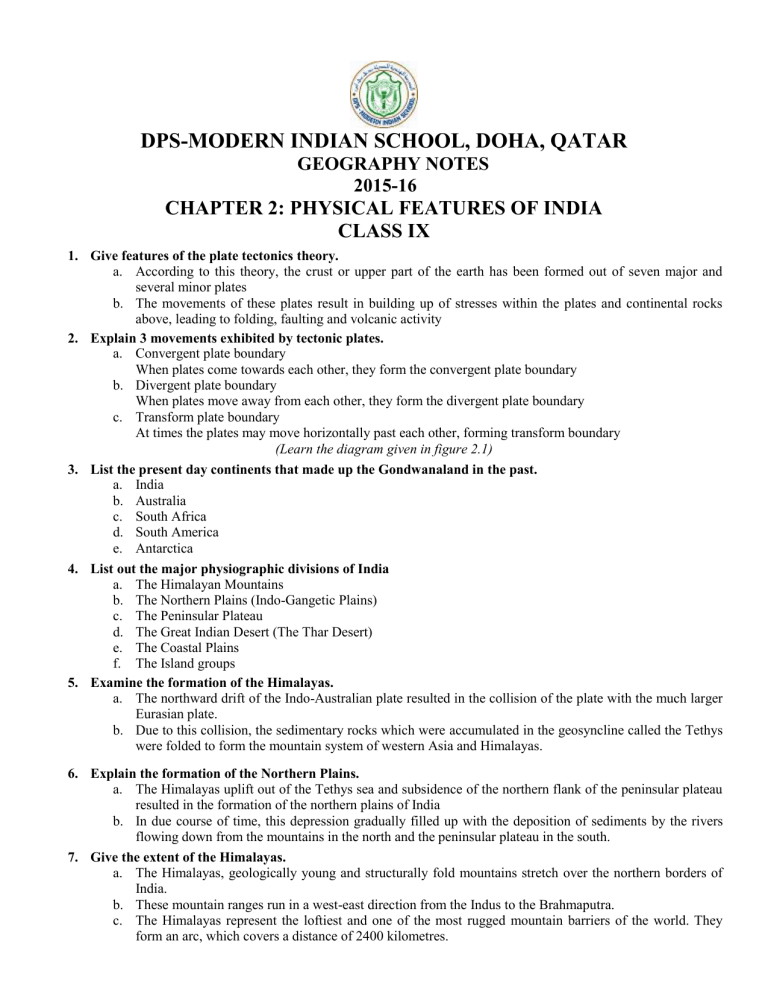
DPS-MODERN INDIAN SCHOOL, DOHA, QATAR
GEOGRAPHY NOTES
2015-16
CHAPTER 2: PHYSICAL FEATURES OF INDIA
CLASS IX
1.
Give features of the plate tectonics theory. a.
According to this theory, the crust or upper part of the earth has been formed out of seven major and several minor plates b.
The movements of these plates result in building up of stresses within the plates and continental rocks above, leading to folding, faulting and volcanic activity
2.
Explain 3 movements exhibited by tectonic plates. a.
Convergent plate boundary
When plates come towards each other, they form the convergent plate boundary b.
Divergent plate boundary
When plates move away from each other, they form the divergent plate boundary c.
Transform plate boundary
At times the plates may move horizontally past each other, forming transform boundary
(Learn the diagram given in figure 2.1)
3.
List the present day continents that made up the Gondwanaland in the past. a.
India b.
Australia c.
South Africa d.
South America e.
Antarctica
4.
List out the major physiographic divisions of India a.
The Himalayan Mountains b.
The Northern Plains (Indo-Gangetic Plains) c.
The Peninsular Plateau d.
The Great Indian Desert (The Thar Desert) e.
The Coastal Plains f.
The Island groups
5.
Examine the formation of the Himalayas. a.
The northward drift of the Indo-Australian plate resulted in the collision of the plate with the much larger
Eurasian plate. b.
Due to this collision, the sedimentary rocks which were accumulated in the geosyncline called the Tethys were folded to form the mountain system of western Asia and Himalayas.
6.
Explain the formation of the Northern Plains. a.
The Himalayas uplift out of the Tethys sea and subsidence of the northern flank of the peninsular plateau resulted in the formation of the northern plains of India b.
In due course of time, this depression gradually filled up with the deposition of sediments by the rivers flowing down from the mountains in the north and the peninsular plateau in the south.
7.
Give the extent of the Himalayas. a.
The Himalayas, geologically young and structurally fold mountains stretch over the northern borders of
India. b.
These mountain ranges run in a west-east direction from the Indus to the Brahmaputra. c.
The Himalayas represent the loftiest and one of the most rugged mountain barriers of the world. They form an arc, which covers a distance of 2400 kilometres.
8.
Why are the Himalayas known as young fold mountains? a.
Himalayas have been formed as a result of tectonic forces colliding with each other resulting in the rising up of the land mass which resembles a fold b.
They are young as they have been formed in the Tertiary time period and are gaining height by a few inches every year.
9.
Describe the three parallel ranges of the Himalayas.
Greater Himalaya or Himadri : a.
The northernmost range is called the Great or Inner Himalayas or the Himadri. b.
It is the most continuous range consisting of the loftiest peaks with an average height of 6000 metres. c.
It contains all the prominent Himalayan peaks. d.
It is perennially snow bound, and a number of glaciers descend from this range. e.
The core of this part of Himalayas is composed of Granite.
Lesser Himalaya or Himachal : a.
The range lying to the south of the Himadri forms the most rugged mountain system and is known as
Himachal or Lesser Himalayas b.
The ranges are mainly composed of highly compressed and altered rocks c.
While the ‘Pir Panjal’ range forms the longest and the most important range, the Dhaula Dhar and the
Mahabharat ranges are also prominent ones d.
This range consists of the famous valley of Kashmir, the Kangra and the Kullu valley of Himachal
Pradesh. This region is well known for hill stations
Outer Himalaya or Shivaliks: a.
The outermost range of the Himalayas is called the Shiwaliks. b.
They extend over a width of 10-50 kilometres and have an altitude varying between 900-1100 metres. c.
These ranges are composed of unconsolidated sediments brought down by rivers from the main
Himalayan ranges located farther north d.
The longitudinal valley lying between lesser Himalayas and the Shiwaliks are called Duns. Examples are
Dehra Dun and Kotli Dun.
11. On the latitudinal basis, identify and explain the different Himalayan ranges. a.
Punjab Himalayas: Kashmir Himalayas: Himachal Himalayas:
The part of the Himalayas lying between Indus and Satluj has been traditionally called as Punjab
Himalayas, but it is also regionally called as Kashmir and Himachal Himalayas b.
Kumaon Himalayas
The part of the Himalayas lying between Satluj and Kali rivers is called Kumaon Himalayas c.
Nepal Himalayas
The Kali and Tista rivers demarcate the Nepal Himalayas d.
Assam Himalayas
The part lying between Tista and Dihang rivers is called Assam Himalayas
10.
Give features of the Purvanchal. a.
These hills running through the north-eastern states are mostly composed of strong sandstones which are sedimentary rocks b.
Covered with dense forests, they mostly run as parallel ranges and valleys c.
The Purvanchal comprises of the Patkai Bum Hills, the Naga Hills, the Manipur Hills and the Mizo Hills
11.
Give features of the Northern Plains of India. a.
The northern plain has been formed by the interplay of the three major river systems, namely the Indus, the Ganga and the Brahmaputra along with their tributaries. b.
The plain being about 2400 kilometres long and 240-320 kilometres broad, it is a densely populated physiographic division. c.
With a rich soil cover combined with adequate water supply and favourable climate, it is agriculturally a very productive part of India. d.
The northern plains is broadly divided into three sections.
12.
List out and explain the four regions of the Northern Plains based on the variations in its relief features.
Bhabar : a.
The rivers, after descending from the mountains deposit pebbles in a narrow belt of about 8-16 kilometres in width lying parallel to the slopes of the Shiwaliks. It is known as Bhabar b.
All the streams disappear in this Bhabar belt as they start flowing under the stones and pebbles.
Terai : a.
South of the Bhabar belt, the streams and rivers re-emerge and create a wet, swampy and marshy region called the Terai b.
This was a thickly forested region teeming with wildlife
Bangar : a.
The largest part of the Northern plains is formed of old alluvium b.
They lie above the flood plains of the rivers and present a terrace like feature. c.
The soil in this region contains calcareous deposits locally called Kankar
Khadar : a.
The newer, younger deposits of the flood plains are called Khadar b.
They are renewed almost every year and so are fertile, thus ideal for intensive agriculture
13.
Give a brief description of the peninsular plateau. a.
The peninsular plateau is a tableland composed of the old crystalline, igneous and metamorphic rocks. b.
It was formed due to the breaking and drifting of the Gondwanaland and thus, making it a part of the oldest landmass. c.
The plateau has broad and shallow valleys and rounded hills d.
This plateau consists of two broad divisions, namely the central highlands and the Deccan plateau
14.
Distinguish between Central Highlands and Deccan Plateau
Central Highlands: a.
The part of the Peninsular plateau lying to the north of the Narmada river covering a major area of the
Malwa Plateau is called central highlands b.
The Vindhyan range is bounded by the central highlands on the south and the Aravallis on the north west c.
The further westward extension gradually merges with the sandy and rocky desert of Rajasthan d.
The flow of the rivers draining this region, namely the Chambal, the Sind, the Betwa and Ken is from southwest to northwest thus indicating the slope.
The Deccan Plateau: a.
The Deccan plateau is a triangular landmass that lies to the south of the river Narmada b.
The Satpura range flanks its broad base in the north while the Mahadev, the Kaimur hills and the
Maikal range form its eastern extensions c.
The Deccan plateau is higher in the west and slopes gently eastwards d.
Three prominent hill ranges from the west to east are the Garo, the Khasi and the Jaintia Hills
15.
Distinguish between Western Ghats and Eastern Ghats.
Western Ghats Eastern Ghats
Western Ghats lie parallel to the western coast. They lie parallel to the eastern coast.
They are continuous and can be crossed through passes only.
Their average elevation is 900-1600 metres.
The highest peak of the Western Ghats is Anaimudi and its altitude is 2695 metres.
The Eastern Ghats are discontinuous and irregular and are dissected by rivers draining into the Bay of Bengal.
Their average elevation is 600 metres.
The highest peak of the Eastern Ghats is Mahendragiri and its altitude is 1501 metres.
16.
What is orographic rainfall? a.
This rainfall mostly occurs on mountains and plateaus b.
The side of the mountain which faces moist winds is known as windward side. This side receives maximum rainfall. For example: Mumbai c.
Whereas, the other side of the mountain is known as rain shadow area. It receives least amount of rainfall because by the time the winds reach this place, they hardly have any moisture left. Example: Pune
17.
Give a brief description of the Indian Desert a.
The Indian desert lies towards the western margins of the Aravalli Hills. d.
b.
It is an undulating sandy plain covered with sand dunes. c.
This region receives very low rainfall, below 150 mm per year.
It has arid climate with low vegetation cover.
18.
Distinguish between western coastal plains and eastern coastal plains
Western Coastal Plains
The western coastal plain is sandwiched between the
Western Ghats and the Arabian sea.
They are narrow.
The northern part of the coast is called the Konkan
(Mumbai-Goa), the central stretch is called the Kannad plain while the southern stretch is referred to as the
Malabar coast.
They are devoid of any delta as the west flowing rivers form the estuaries.
It is located between the Eastern Ghats and the Bay of
Bengal.
They are wide.
Eastern Coastal Plains
In the northern part, it is referred to as the Northern
Circars, while the southern part is called the
Coromandal coast.
They are spotted with the deltas formed by the east – flowing rivers.
19.
Give a brief description of the island groups of our country
Lakshadweep Islands: a.
Lakshadweep island group lie close to the Malabar coast of Kerala. b.
This group of islands is composed of small coral islands. c.
Earlier, they were known as Laccadive, Minicoy and Amindive. d.
Kavaratti island is the administrative headquarters of Lakshadweep. e.
The Pitli island, which is uninhabited, has a bird sanctuary. f.
This island group has a total number of 36 islands.
Andaman and Nicobar Islands: a.
The elongated chain of islands located in the bay of Bengal extending from north to south are called
the Andaman and Nicobar islands. b.
The islands of this archipelago are of volcanic origin. c.
The entire group of islands is divided into two broad categories: the Andaman in the north and the
Nicobar in the south and are separated by 10 o N latitude. d.
Port Blair is the administrative headquarters of Andaman and Nicobar island group. e.
India’s only active volcano is found on Barren Island in Andaman and Nicobar group of islands. f.
This island group has a total number of 552 islands.
